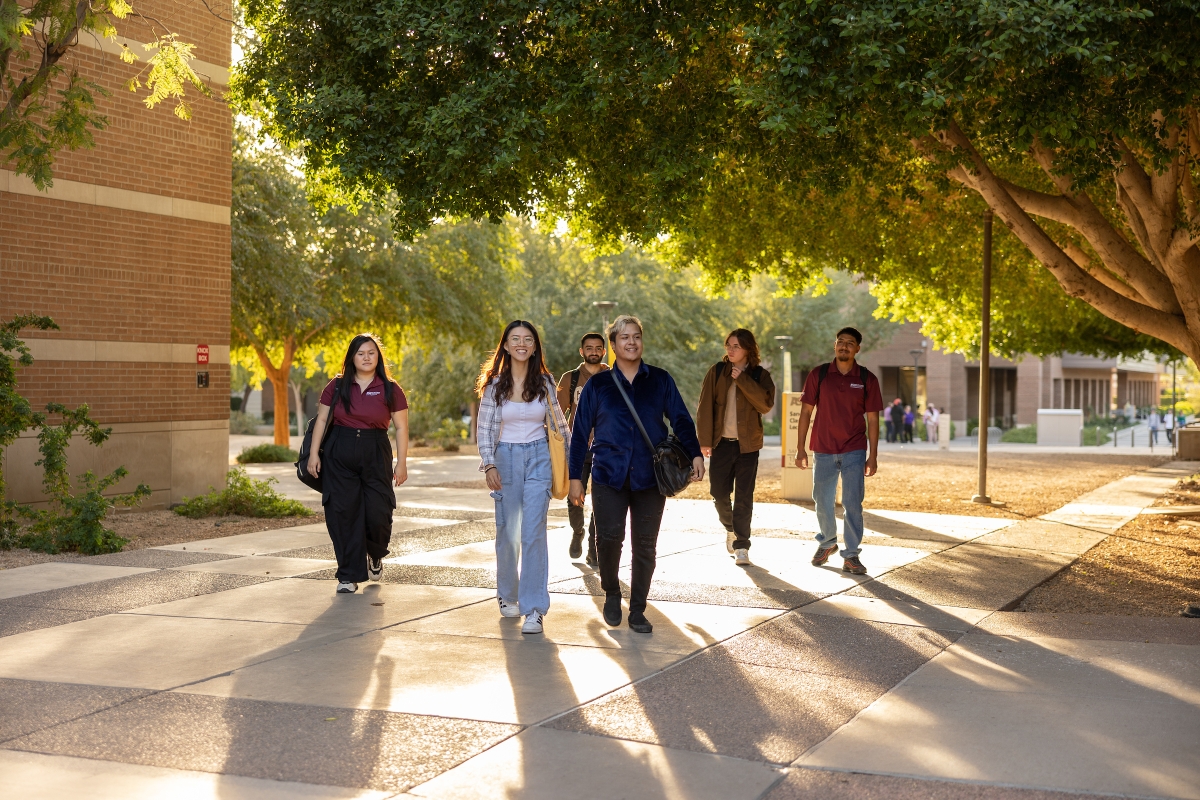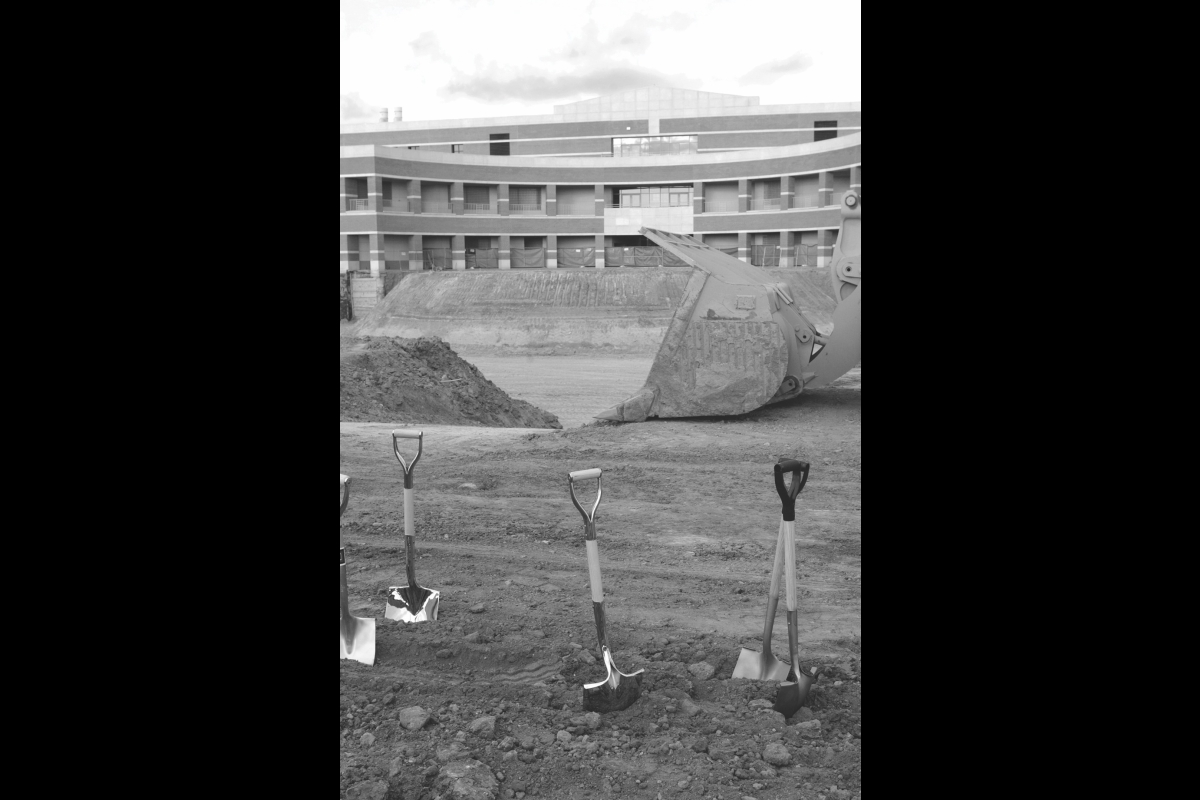Award recognizes ASU's contributions to the West Valley community

Fletcher Lawn, the Sands Classroom Building, the Casa de Oro residential hall and the Sun Devil Fitness Center at ASU’s West Valley campus in Phoenix, Arizona, as seen from above on March 17, 2023. Photo by Samantha Chow/Arizona State University
Editor’s note: This story is featured in the 2024 year in review.
Forty years ago, Arizona State University started its expansion into the West Valley to meet the educational needs of the region’s growing community.
And this month, the university was honored for doing just that.
On Oct. 24, the West Valley campus was presented with the West Valley Regional Advancement Award, which recognized the institution for successfully working to strengthen and transform the area’s position for economic growth.
The award was presented at WESTMARC’s 32nd Annual Best of the West Awards Dinner, which took place in Glendale’s Desert Diamond Arena.
“Many of you were here one year ago, when ASU President Michael Crow announced the new name for our campus — West Valley campus — to further solidify ASU’s commitment and connection to you and to our West Valley community,” said Todd Sandrin, vice provost of the West Valley campus, who accepted the award. “All of us up here live that promise every day, with the exciting new construction of the largest residence hall ever built on campus and a new state-of-the-art academic building opening this spring.”
WESTMARC, or the Western Maricopa Coalition, is a public-private partnership formed in 1990 to address important issues facing the West Valley’s economic prosperity.
“We brought three new schools to campus and degrees designed to support the growing workforce needs of this vibrant community,” continued Sandrin, dean of the New College of Interdisciplinary Arts and Sciences. “Tonight this Regional Advancement recognition is confirmation that you, our neighbors, think we are on the right track.”
Campus history
The recognition takes place as the campus marks 40 years since the Arizona legislature approved its establishment in 1984.
But the effort to create a West Valley campus was a long, and at times frustrating, one that goes back as far as 1963 and includes a time when 525 acres of land were gifted for the school by Goodyear Tire and Rubber Company — and then ungifted.
In the end, one woman, Barbara Ridge, is credited with rallying the community to create the campus. Ridge had four young children and was attending Glendale Community College. She wanted to continue her education but the drive to Tempe to finish her degree made that impossible.
The community activist, together with her husband, Sterling Ridge, a mayor and lawmaker, and the Westside Citizens Committee for Higher Education, were instrumental in the grassroots effort to build, support and establish a campus in West Phoenix.
The groundbreaking took place in 1986 at the intersection of 47th Avenue and Thunderbird Road.
Read more
How the West campus was won: West Valley location began as one student's project and grew into a formidable grassroots campaign
And the school has been growing ever since.
One-of-a-kind location
The West Valley campus is distinct from any of ASU’s other campuses. Conceived by architects Gerald McSheffrey and Jack DeBartolo, there are large, lush green spaces, tree-lined paths, fountains and columned walkways reminiscent of traditional college campuses.
That was by design.
“We had the ability to start with a blank desert canvas and really design this thing,” Sandrin said. “We don't have many campuses nationwide that are designed from the ground up like this. It's very rare.”
Sandrin said that most college campuses grow incrementally, adding buildings with different architectural styles, “but this one has always been committed to a design.”
“Initially the quad was built around a footprint of (the University of) Oxford, a classic mall model,” he said. “And every new building we've added has really retained that kind of motif that makes it look very beautiful and architecturally coherent.”
Student growth
The school initially served as an upper division campus for the community college population.
The first year, ASU West campus (as it was then called) had 32 students graduating in nine different degree programs. Since then, nearly 35,000 students have earned degrees from there. In fall 2024, ASU had a 25% increase in new students.
“This kind of growth is unheard of anywhere in the nation,” Sandrin said.
In March 2023, three new schools — in business, forensics and engineering — were added to the West campus.
• The School of Technology, Innovation and Entrepreneurship in the W. P. Carey School of Business.
• The School of Interdisciplinary Forensics in the New College of Interdisciplinary Arts and Sciences.
• The School of Integrated Engineering in the Ira A. Fulton Schools of Engineering.
In August, Casa del Valle, the newest and largest residential community on the West campus opened with 507 double-occupancy, suite-styled units.
And in October 2023, it got a new name — West Valley campus — to better reflect the growth of the community it serves.
Future plans
The 300-acre campus still has plenty of room to grow.
In spring 2025, a new academic building will open its doors. The three-story, 55,000-square-foot facility will house student gallery space, computer labs, faculty offices and future growth spaces.
ASU also has plans to create the Education Complex at ASU within the Mary Lou Fulton Teachers College. This new initiative will serve as a collaborative hub for advancing educational innovation and social embeddedness. The complex aims to explore key questions and global trends shaping the future.
Read more
ASU's West campus expanding to serve the evolving West Valley: Governor, other policymakers among hundreds at event celebrating launch of new schools in forensics, business and engineering; 2 new buildings
The facility will feature adaptable spaces that can transform into classrooms, demonstration areas, or labs, along with mobile units that bring educational resources directly into the community.
Close community
The West Valley campus is a tight-knit community of faculty and students that provides both a small-college experience alongside top-tier research — with more than 120 undergraduate, graduate degree and PhD programs, including an honors curriculum.
Sedra Shahin, a student who is majoring in business administration, business law, and business public service and public policy, found herself at the West Valley campus because its majors aligned with her interests.
She joined seven clubs in her first year and now represents around 5,000 students as the campus student body president.
“I fell in love with the community,” said Shahin, who is now a third-year student. “I made lots of friends. You can't really walk around campus without bumping into like five people you know around here. And I really like that. I found a community of people that I really liked. I was able to truly feel like it was almost home.”
The campus has a 1-to-13 faculty-student ratio, which allows students to have one-on-one connections with teachers in every class.
“When you come to West Valley, you're not just coming to a campus,” Shahin said. “You're stepping into a community, into a world of possibilities of making connections that are personable and that will stick with you throughout your ASU journey and hopefully afterward.”
The West Valley campus is known for traditions that make it special, such as the Solera Experience, a one day, unity-building event for first-year and transfer students that includes a boat competition; and the Golden Tradition, when students pass through the Paley Gates at the campus entrance on their first day of classes. When they graduate, they will pass through the gates again — this time moving on toward their future.
Shahin and her peers in student government hope to help ASU grow enrollment from around 5,000 to 15,000 students — a goal set during the West Valley Forward initiative that launched in spring 2023.
“My hope is that we continue to grow our campus and our resources and that we continue to serve the residents of Arizona, but also all ASU students, whether they're international, online or wherever they are.”
According to Bobbi Magdaleno, executive director of government and community engagement at the West Valley campus, the campus means everything to its surrounding community.
“We get to have a large, highly ranked university right in our backyard. It means a lot to the communities that we are here,” said Magdaleno, who lives in Glendale.
Magdaleno, who describes the campus as “uniquely beautiful,” has been working at the campus for 36 years — long enough to watch the school evolve.
“Maybe I'm a little biased, but having been here that long and seeing how we originally developed and the vision that so many people have had over the years, and then watching the programs come together and traditions start and continue — it's just been a treasure.”
More Sun Devil community
Founders’ Day 2025 celebrates legacy and innovation at ASU
"Honor the past, celebrate the present and invent the future." This motto encapsulates the spirit of Founders' Day, a signature event hosted by the Arizona State University Alumni Association to…

ASU preps America's veterans for what's next
Every year, over 200,000 active-duty military members trade their uniforms for civilian attire as they embark on the next chapter of their lives filled with both promise and uncertainty.The shift…
Red Cross president, Pulitzer Prize finalist to speak at ASU's spring commencement ceremonies
A Pulitzer Prize finalist for poetry and an Arizona State University graduate who is the president of the International Federation of Red Cross and Red Crescent Societies will be the featured…





